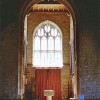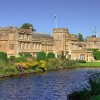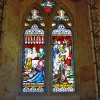The Parish Church at Shillingstone is north of the village, where it stands on a hill overlooking the Stour valley. It is thought a wooden church stood on this site during the reign of Edward the Confessor, when the manor here was held by Harold Earl Godwin who became King Harold II, the last Saxon king of England. The manor was granted to the Norman Schelin family by William the Conqueror; they were recorded as the Lords of the Manor in the Domesday Book and it was during the family’s tenure of the manor that a stone church was built.
The Church of The Holy Rood reveals its Norman ancestry in parts of the walls and some of the windows that have survived since the 12th century. The building then consisted of a small rectangular nave and a narrower chancel.
The walls of the building are of flint rubble, banded flint and rubble and ashlar; the roof tiles are modern. Its nave is in the Perpendicular style but the original Norman building had narrow rounded windows and some of these were brought to light during restoration works in 1858 and 1888. During these works the two galleries (one above the other), the founder’s tomb, an ambry and an ancient priest’s door were cleared away and the north aisle and north chapel were added.
The chancel arch is of the 14th century and the embattled west tower was built late in the 15th century and houses five bells – one dated 1622 and another of that date recast in 1892 as well as one of 1634 and two of 1734. The south porch was added during the 16th century. Further works in 1902/3 included the rebuilding of parts of the chancel and that included a new roof with a blue ground inset with stars, new choir stalls and an oak screen surmounted by a large wooden cross. The 17th century pulpit was a gift to the church from a London merchant in recognition and thanks for the shelter from the Plague provided to him by the village.
In the churchyard is the base of an old cross, probably a preaching cross from the early 15th century. Another is on a small green in the village and has an ancient base but the slender weathered pillar is deceptive; that was added in 1903. There is a third cross in the village: a War Memorial.



